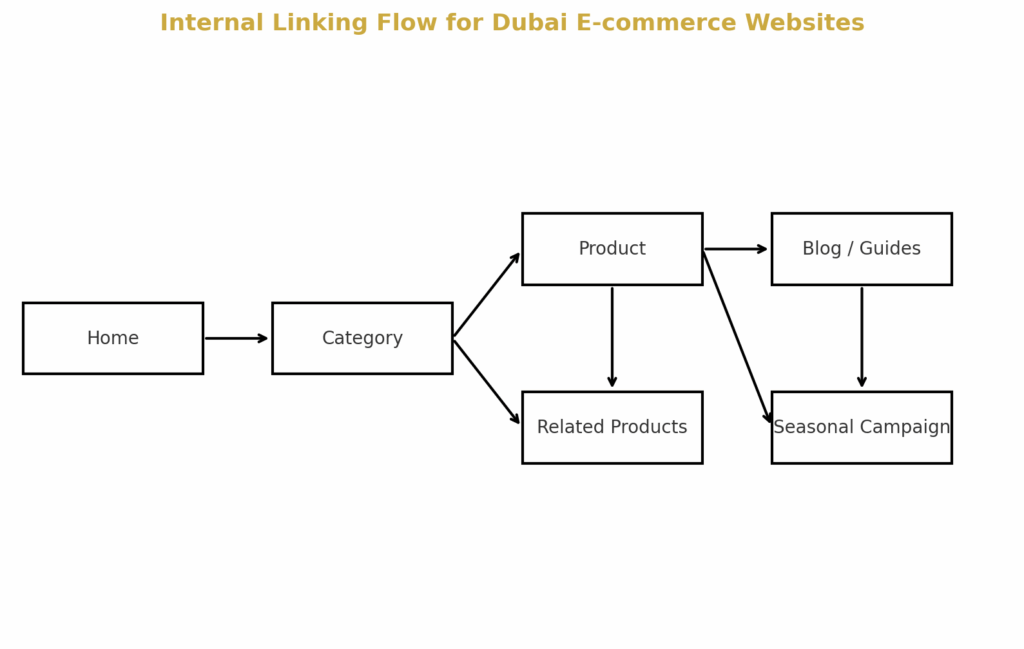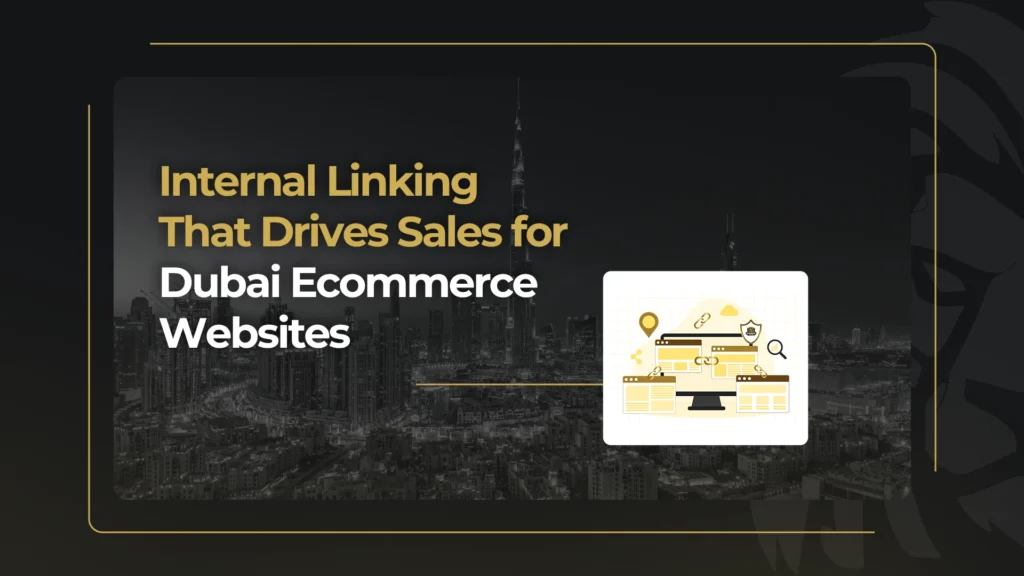Dubai’s ecommerce market is one of the fastest-growing in the region, with shoppers filling carts across fashion, beauty, electronics, and luxury goods. While brands compete heavily on ads, pricing, and delivery, one area often overlooked is internal linking. For ecommerce, this isn’t just a technical SEO task, it’s a sales multiplier.
By guiding users seamlessly between categories, products, and content, internal linking helps shoppers discover more of your catalogue, increases average order value, and strengthens SEO visibility. For Dubai retailers competing with Amazon, Noon, Namshi, or Ounass, mastering this can be the difference between a bounce and a basket.
Why Internal Linking Matters for Dubai Ecommerce
Internal linking shapes how users move through your site and how search engines understand your structure. For a shopper browsing “men’s trainers Dubai”, an optimised category page should link directly to related subcategories (running shoes, lifestyle sneakers) and products (Adidas, Nike, Puma).
Without strong linking, these pages sit in silos, forcing the user to start over. With smart linking, you create natural upsell and cross-sell paths. For instance, linking from an abaya product page to “modest fashion accessories” helps customers build complete outfits, driving higher AOV.
In Dubai’s bilingual and mobile-first market, internal linking also improves product discoverability in Arabic and English, keeping users engaged and reducing cart abandonment.
The Local Ecommerce Landscape
Dubai’s ecommerce market blends global dominance with local flair. Giants like Namshi and Ounass thrive by combining slick navigation with curated cross-links, while multi-brand retailers like Carrefour and Sharaf DG use category linking to surface endless options.
Consumer behaviour is also shaped by local expectations:
-
Shoppers compare online before buying in malls like Dubai Mall and Mall of the Emirates.
-
Cash on delivery (COD) and same-day delivery are key trust factors.
-
Seasonal spikes (Ramadan, Dubai Shopping Festival) demand flexible linking between campaigns, offers, and products.
These dynamics make internal linking a critical lever for both SEO visibility and conversion optimisation.
Advanced Internal Linking Strategies for Dubai Ecommerce Websites
Not all links are created equal. In Dubai’s competitive ecommerce market, internal linking needs to go beyond basic navigation to actively drive sales. The strategies below show how retailers can use links to boost product discoverability, increase average order value, and guide shoppers smoothly from browsing to checkout.
1. Use Sales-Driven Anchor Text
Generic “click here” links waste opportunities. Instead, use anchor text that reflects search intent and buyer behaviour in Dubai. Examples:
-
English: “Same-day laptop delivery in Dubai” linking to laptops category.
-
Arabic: “فساتين سهرة في دبي” linking to evening dresses.
This not only improves SEO but reassures shoppers that your site caters to their local needs.
2. Build Breadcrumbs That Keep Shoppers Exploring
Breadcrumbs reduce bounce rates by giving users clear paths back to categories and subcategories. They also strengthen internal linking signals for search engines.
For instance: Home > Women’s Fashion > Abayas > Black Abayas
Breadcrumbs in both Arabic and English reinforce bilingual optimisation.
3. Link Categories and Products to Maximise Basket Value
-
Upselling: Electronics retailers link smartphones > premium accessories (cases, wireless chargers).
-
Cross-selling: Fashion brands link abayas > hijabs > accessories.
-
Category depth: Furniture stores link “Living Room Furniture” > Sofas > Sofa Beds, ensuring customers always find the next relevant option.
These links mimic a personal shopper experience, nudging customers toward larger baskets.
4. Turn Blogs and Guides into Sales Funnels
Blogs and guides are powerful sales drivers when linked properly. A piece like “Best Skincare for Dubai’s Summer Heat” should link directly to moisturisers, sunscreens, and serums within the beauty catalogue.
Retailers often miss this, publishing content but not connecting it to products. In Dubai, where search intent is often seasonal, content-linked commerce is a huge untapped advantage.
5. Power Up Seasonal and Campaign Linking
During Ramadan or DSF, shoppers look for curated deals. Internal linking should reflect this by connecting:
-
Ramadan campaign pages > categories > specific products.
-
DSF landing pages > high-discount items.
By archiving and reusing these structures, retailers can quickly relaunch seasonal SEO campaigns each year.
6. Optimise Links for Crawlability and Conversions
Internal linking isn’t only about UX – it’s crawlability.
-
Reduce crawl depth by ensuring popular categories are reachable within 3 clicks.
-
Use HTML links over JS for search engine accessibility.
-
Avoid broken links from expired campaigns; redirect to live, relevant categories.
This ensures Google indexes your key sales-driving pages, not dead ends.

Measuring the Sales Impact of Internal Linking for Dubai Ecommerce
Internal linking is measurable. Key indicators for Dubai ecommerce include:
-
Click-through rates from category to product pages.
-
Average order value (AOV) uplift after adding cross-links.
-
Conversion rate improvements from content-linked journeys.
-
Revenue attribution from seasonal campaign linking.
Conclusion
For Dubai ecommerce retailers, internal linking is more than navigation, it’s a sales engine. By using bilingual anchor text, breadcrumbs, seasonal campaign linking, and content-to-product journeys, brands can increase discoverability, average order values, and conversions.
👉 At Dominate, we help Dubai ecommerce brands design internal linking structures that don’t just improve SEO, they drive measurable sales. Book a consultation today to start optimising your linking strategy for revenue growth.
FAQ Section
What is internal linking and why is it important for ecommerce websites?
Internal linking refers to the practice of linking one page of a website to another page within the same domain. For ecommerce websites, it is crucial as it enhances navigation, improves SEO, and increases the likelihood of conversions by guiding customers to relevant products and content.
How can Dubai SMEs implement effective internal linking strategies?
Dubai SMEs can implement effective internal linking strategies by creating a clear site structure, linking related products, and ensuring easy navigation. Regularly updating content and using local keywords can also enhance the effectiveness of these strategies.
What are common SEO challenges faced by ecommerce businesses in Dubai?
Common SEO challenges for ecommerce businesses in Dubai include managing duplicate content, optimising for local search, and maintaining a strong online presence amidst fierce competition. Addressing these issues is vital for improving visibility and sales.
How does internal linking influence sales and customer behaviour?
Internal linking influences sales by improving product discoverability and guiding customers through their shopping journey. Effective links can lead to increased engagement and higher conversion rates, ultimately boosting sales.
What local SEO practices should Dubai ecommerce websites focus on?
Dubai ecommerce websites should focus on local SEO practices such as using local keywords, emphasising community involvement, and tailoring content to reflect the unique characteristics of Dubai’s market. This localisation can significantly enhance visibility and customer connection.
